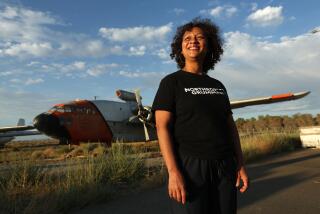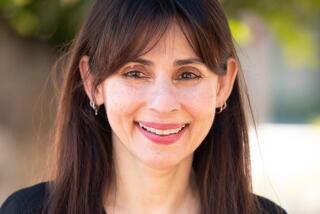Progress by Degrees
- Share via
GLENDALE — When Glendale Community College celebrates its 70th anniversary today, the usual raft of dignitaries and alumni will wax nostalgic for a college that has grown into a 13,000-student learning mecca seven decades after graduating its first class of 12.
But the school’s growth has been measured in more ways than enrollment and acreage.
A visit to the 100-acre hillside campus is a reminder of both the college’s progress and its beginnings, when it was populated exclusively by white students--some of whom, by many accounts, had little sense of their own aspirations.
“People don’t come here just to be somewhere, to just pass time,” college President John Davitt said. “People are here to get ahead. All kinds of people who are serious about their educations. We’re much larger and far more diverse than we’ve ever been.”
Glendale Community College, which opened Sept. 13, 1927, has enjoyed a blessing of sorts, Davitt said. The growth and increasing diversity of Glendale has prompted similar changes at the community college. When the school was founded, Glendale was predominantly white--with a minor Latino population--and small; the 1920 census counted fewer than 3,000 residents in the area.
Now Glendale is home to nearly 200,000, with large Asian, Armenian and Latino communities.
“There was a time when diversity here meant Protestants and Presbyterians,” said Harold B. Cochrane, emeritus dean at the school. He has served as a chemistry professor and administrator since joining the faculty in 1946.
“It was a white college when I got here,” he continued. “But it’s diverse now, and that makes me very happy. I’m kind of jealous of the way things are now.”
Cochrane noted how the computer lab on campus would have made his early teaching days more effective for students and faculty, how the various languages spoken on campus could have expanded the student body’s perspective on the world around them, and how class sizes are smaller now, despite the school’s overall growth.
“There’s a college atmosphere here that I like,” said Carlos Sanchez, 22, a second-semester student. “But people come here to take care of business and leave. It’s not like high school, people wasting time and hanging out.”
Sanchez, a native of Peru, said the diversity on campus enhances its collegiate atmosphere. And Sanchez said the school serves the majority of students who want to transfer to four-year universities.
“I want to go to UCLA; most of us want to go somewhere in the UC [system],” he said.
But growth has not come without a problem, echoed by faculty and students alike: parking.
“That’s definitely the biggest hassle,” said Guillermo Martinez, 18, a second-semester student. “So many people are coming here, but parking is limited.”
If parking is the biggest concern, students say, the school has a lot to celebrate today. Glendale Community College is indeed a success in terms of ushering its students into four-year schools; last year, it saw more transfers to the University of California and California State University systems than ever before--750 students.
Ransford said the college ranks in the top 10 of the state’s 107 community colleges in terms of transfers to four-year universities.
But the successes the college will celebrate tonight are even more remarkable considering the literally ground-shaking problems that nearly shuttered the school.
Originally housed in a single building in downtown Glendale, sharing space with a high school, the college for more than three years was forced into a small pavilion of tents outside its downtown address after the 1933 Long Beach earthquake caused serious foundation damage to a number of buildings in the region.
Alum Ray Edwards, a student at the school from 1936 to 1939 who went on to become chief executive officer of Glendale Federal Bank, recalled classes that endured weather interruptions while students worked inside the 15 tents that made up the campus.
A municipal bond issue, matched by federal Works Progress Administration money, funded construction of the school’s current campus. Two buildings, including the current administration building, originally composed the entire campus. Over the past two decades, construction led to a Spanish-styled compound of buildings and grass lawns now teeming with students. The campus is so crowded that nearly a dozen trailers, installed more than 10 years ago as a temporary solution to a lack of classroom space, are still in use.
A chocolate-and-berry concoction will stand in today for the college’s birthday cake at the $50-a-head banquet in the center of campus during a ceremony beginning at 4 p.m.
Faculty, administrators and guests such as state Assemblyman Scott Wildman (D-Los Angeles) and Glendale Mayor Larry Zarian are scheduled to attend the celebration. But for those who failed to reserve a seat or are not able to afford the price of Maryland crab cakes and grilled tenderloin, the event still has meaning.
“It’s a big deal, a 70th birthday,” said Sanchez, an aspiring sports reporter.
“The campus is decked out, even if students don’t know much about the dinner.”
More familiar to students and a part of the anniversary celebration will be the $22.5 million worth of new construction.
The newly refurbished library and the San Gabriel Building, which houses computer labs, classrooms and other facilities, will be open for tours at the celebration. The library was nearly doubled in size by the new construction.
These facilities, according to administrators, will be used by programs unique to the Glendale campus, including the school’s aviation program and its Center for Visual Media, which offers animation training.
(BEGIN TEXT OF INFOBOX / INFOGRAPHIC)
GLENDALE COLLEGE / AT A GLANCE
* Opened Sept. 13, 1927, as Glendale Junior College.
* About 13,000 students currently enroll each semester, plus 7,000 non-credit students. More than 1 million students have enrolled in the college’s 70 years.
Ethnic breakdown
* White: 52.1%
Latino: 24.8%
African American: 2.6%
American Indian: 0.7%
Asian/Pacific Islander: 19.1%
Other: 0.7%
* The white category includes Armenian students, who make up 30% of the total students.
More to Read
Sign up for Essential California
The most important California stories and recommendations in your inbox every morning.
You may occasionally receive promotional content from the Los Angeles Times.













